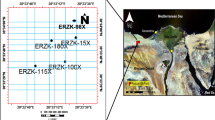Abstract
Bangestan reservoir includes Sarvak and Ilam formations in the Mansouri oilfield consists mainly of carbonate rocks. In this research, we tried to overcome the problems in reservoir studies using well-logs data which are available in almost all wells in the oilfield. For this purpose, well-logs data from wells A and C were used as input data for the construction of electro-facies modeling. In the following, a model with 5 electro-facies was created and then this model was calibrated by microfacies in well A and core data such as porosity and permeability in the both wells in related to Sarvak Formation (wells A and C). The results of calibration reveal a good correlation between core data and electro-facies, so this model was propagated to un-cored wells in oilfield. The results of the study showed that reservoir quality from electro-facies 1 to 5 increases, respectively and pay zones of 2 in Ilam, 4 and 6 in Sarvak formations have the best reservoir quality. In order to future study, the velocity deviation log (VDL) that is mainly dependent on the type of dominant porosity in reservoir, was investigated to the specified electro-facies. Therefore, this log can be used as a tool for establishment of connection between porosity types and petrophysical data such as electro-facies.
Similar content being viewed by others
References
Alavi, M., 2007, Structures of the Zagros fold-thrust belt in Iran. American Journal of Science, 307, 1064–1095.
Anselmetti, F.S. and Eberli, G.P., 1999, The velocity-deviation log: a tool to predict pore type and permeability trends in carbonate drill holes from sonic and porosity or density logs. American Association of Petroleum Geologists Bulletin, 83, 450–466.
Chehrazi, A., Rezaee, R., and Rahimpour-Bonab, H., 2011, Pore-facies as a tool for incorporation of small-scale dynamic inFormation in integrated reservoir studies. Journal of Geophysics and Engineering, 8, 202–224.
Hajikazemi, E., Al-Aasm, I.S., and Coniglio, M., 2010, Subaerial exposure and meteoric diagenesis of the Cenomanian-Turonian Upper Sarvak Formation, southwest Iran. In: Leturmy, P. and Robin, C. (eds.), Tectonic and Stratigraphy Evolution of Zagros and Makran during the Mesozoic–Cenozoic. Geological Society of London, Special Publications, 330, p. 253–272.
Haq, B.U., Hardenbol, J., and Vail, P.R., 1988, Mesozoic and Cenozoic chronostratigraphy and cycles of sea-level change. In: Wilgus, C.K., Hastings, B.S., Posamentier, H., Van Wagoner, J., Ross, C.A., and Rendal, C.G.S. (eds.), Sea Level Changes: An Integrated Approach. Society of Economic Paleontologists and Mineralogists, Special Publications, 42, p. 71–108.
James, G.A. and Wynd, G.G., 1965, Stratigraphic nomenclature of Iranian oil consortium agreement area. American Association of Petroleum Geologists Bulletin, 49, 2182–2245.
Kadkhodaie-Ilkhchi, R., Rezaee, R., Moussavi-Harami, R., and Kadkhodaie-Ilkhchi, A., 2013, Analysis of the reservoir electro-facies in the framework of hydraulic flow units in the Whicher Range Field, Perth basin, Western Australia. Journal of Petroleum Science and Engineering, 111, 106–120.
Lee, S.H. and Datta-Gupta, A., 1999, Electro-facies characterization and permeability prediction in carbonate reservoirs: role of multivariate analysis and nonparametric regression. Annual Technical Conference and Exhibition of Society of Petroleum Engineers, Houston, Oct. 3–6, p. 1–13.
Ma, Z.Y., Wang, H., Sitchler, J., Gurpinar, O., Gomez, E., and Wang, Y., 2014, Mixture decompositions and lithofacies clustering from wire line logs. Journal of Applied Geophysics, 102, 10–20.
Mehrabi, H. and Rahimpour-Bonab, H., 2013, Paleoclimate and tectonic controls on the depositional and diagenetic history of the Cenomanian–early Turonian carbonate reservoirs, Dezful Embayment, SW Iran. Facies, 60, 147–167.
Noorian, Y., Moussavi-Harami, R., Mahboubi, A., and Abdolahi Moussavi, A.A., 2015, Micro and electro-facies analysis of the Bangestan reservoir in Mansouri oil field. Petroleum Research, 25, 17–29. (In Persian with English abstract).
Perez, H.H., Datta-Gupta, A., and Mishra, S., 2003, The role of electrofacies, lithofacies, and hydraulic flow units in permeability predictions from well-logs: A comparative analysis using classification trees. Annual Technical Conference and Exhibition of Society of Petroleum Engineers, Denver, Oct. 5–8, p. 1–11.
Setudehnia, A., 1978, The Mesozoic succession in S.W. Iran and adjacent areas. Journal of Petroleum Geology, 1, 3–42.
Sfidari, E., Kadkhodaie-Ilkhchi, A., Rahimpour-Bonab, H., and Soltani, B., 2014, A hybrid approach for litho-facies characterization in the framework of sequence stratigraphy: A case study from the South Pars gas field, the Persian Gulf basin. Journal of Petroleum Science and Engineering, 121, 87–102.
Sharland, P.R., Archer, R., Casey, D.M., Davies, R.B., Hall, S.H., Heward, A.P., Horbury, A.D., and Simmon, M.D., 2001, Arabian Plate sequence stratigraphy. GeoArabia Special Publication, ovl. 2, Manama Bah Bahrain, 371 p.
Taghavi, A.A., Mork, A., and Emadi, M.A., 2006, Sequence stratigraphically controlled diagenesis governs reservoir quality in the carbonate Dehluran Field, southwest Iran. Petroleum Geoscience, 12, 115–126.
Tan, P.N., Steinbach, M., and Kumar, V., 2006, Introduction to Data Mining. Pearson Addison Wesley, Boston, 769 p.
Tavakoli, V., Rahimpour-Bonab, H., and Esrafili-Dizaji, B., 2011, Diagenetic controlled reservoir quality of South Pars gas field, an integrated approach. Comptes Rendus Geoscience, 343, 55–71.
Karimian-Torghabeh, A., Rezaee, R., Moussavi-Harami, R., Pradhan, B., Kamali, M.R., and Kadkhodaie-Ilkhchi, A., 2014, Electro-facies in gas shale from well-log data via cluster analysis: A case study of the Perth Basin, Western Australia. Central European Journal of Geoscience, 6, 393–402.
Wolff, M. and Pelissier-combescure, J., 1982, Automatic electro-facies determination. 23rd Annual Logging Symposium Transactions of Society of Professional Well-log Analysts, Texas, Jul. 6–9, p. 23.
Wyllie, G. and Gardner, G.H.F., 1956, Elastic wave velocities in heterogeneous and porous media. Geophysics 21, 41–70.
Ye, S. and Rabiller, P., 2000, A new tool for electro-facies analysis: Multi resolution graph based clustering. 41st Annual Logging Symposium of Society of Petrophysicists and Well Log Analysts, Texas, Jun. 4–7, p. 1–14.
Author information
Authors and Affiliations
Corresponding author
Rights and permissions
About this article
Cite this article
Noorian, Y., Moussavi-Harami, R., Mahboubi, A. et al. Evaluation of reservoir characterization in the framework of electro-facies: a case study from the Bangestan reservoir in the Mansuri oilfield, SW Iran. Geosci J 21, 713–727 (2017). https://doi.org/10.1007/s12303-016-0071-4
Received:
Accepted:
Published:
Issue Date:
DOI: https://doi.org/10.1007/s12303-016-0071-4




